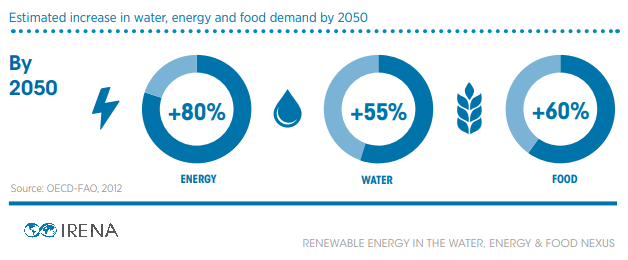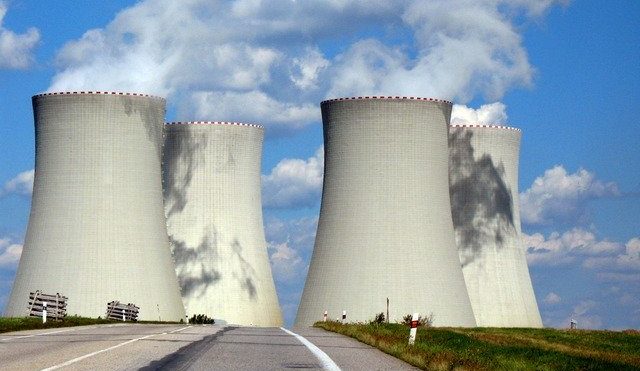What is the connection between renewable energy & water?
Water use and energy production are closely connected. Energy systems use water for manufacturing and maintaining infrastructure, as well as to generate electricity. Modern water systems need energy to operate, from extracting, purifying and delivering, to heating/cooling and treating. The complex relationships between water and energy is collectively known as the ‘water-energy nexus’.
In their 2015 report, IRENA explain how the links between energy and water are becoming more complex. Demand for water resources is increasing, due to population growth and new consumption patterns. At the same time, climate change is altering existing watersheds making access more precarious. The report estimates that by 2050 global demand for energy will increase by 80%, whilst water demand is estimated to increase by over 50%. Traditionally, fossil fuel and freshwater use would increase to meet growing demand. However, continuing this way is not sustainable, and renewable energy can help.

We spoke with REN21 members Kangkanika Neog of The Council on Energy, Environment and Water (CEEW) and Cristina Diez Santos of the International Hydropower Association (IHA), on how renewables can contribute to the water-energy nexus.
What can renewables bring to the water-energy nexus?
First, most renewable energy technologies require significantly less water throughout their lifestyle than traditional fuels. Neog explains the case in India: “While traditional thermal generation requires water during fuel processing, renewables do not. During the power generation stage, water needs for solar photovoltaic (PV) and wind are negligible in comparison to traditional fuels. Some technologies like Concentrated Solar Power (CSP) need more water, but it can be managed through dry cooling”. With water becoming an increasingly precious resource, renewables offer a less water-intensive method of generation.

Second, renewable generation is more resilient to water-related climate events, such as drought or flooding, than fossil fuels. “Given the importance of water for cooling in thermal generation, these plants are highly vulnerable to fluxes in the water supply”. Neog points out that “such vulnerabilities are largely absent in case of renewables”.
Similarly, the distributed and localised nature of renewable power generation makes it more resilient than traditional methods of generation. In times of crisis, local renewable methods can continue to generate energy. Whereas if a key national power plant floods, for example, power may be cut for a whole region.
As well as generating renewable energy using water, hydropower infrastructure can help conserve water and mitigate the impact of climate events. “Hydropower systems, either single or multipurpose, can provide water management services. For example, irrigation, water supply and flood control” Diez Santos explains. “They can store water that can be redistributed in space and time, which creates systemic resilience and capacity to adapt.”

What is the renewables sector doing for water conservation?
Although renewable energy technologies use less water than traditional generation methods, the renewable energy sector can still improve how it uses water.
Diez Santos explains how the IHA is supporting training and project assessments to promote best practice in water management. “Hydropower’s role in sustainably managing freshwater requires a very good understanding of water flows, and impacts at the river basin scale”. “IHA, as a champion of good practice and continuous improvement, supports project assessments and training through the Hydropower Sustainability Assessment Tools.”

One subject both organisations are discussing is the need for integrated policy making. Policy decisions should aim for sustainable systems, which take the water-energy nexus into account. “We need a true integrated approach between water and energy sectors.” Diez Santos tell us, “We must stop working from silos and start developing combined water and energy policies.”
CEEW has taken a similarly integrated approach to future planning in India. The organisation has investigated the impact of different development pathways on the country’s water resources. “We used the shared-socioeconomic pathways (SSP) framework to describe different futures. The framework is based on social, economic and technological drivers, providing five possible scenarios.” Explained Neog. “The study concluded that a development pathway primarily dependent on renewables, with renewables forming 40% and 65% of electricity generation in 2050 and 2095 respectively, has the best outcome.” CEEW predicts that if India follows the development path with increased use of renewables, there will be a reduction in national water use. According to Neog “By increasing the share of renewable energy to align with the development pathway, water use in India will not surpass 2015 levels.
Read the full report from IRENA: ‘Renewable Energy in the Water, Energy & Food Nexus’.
Background
REN21 is the only global renewable energy community of actors from science, governments, NGOs and industry. We provide up-to-date and peer-reviewed facts, figures and analysis of global developments in technology, policies and markets. Our goal: enable decision-makers to make the transition to renewable energy happen – now.





